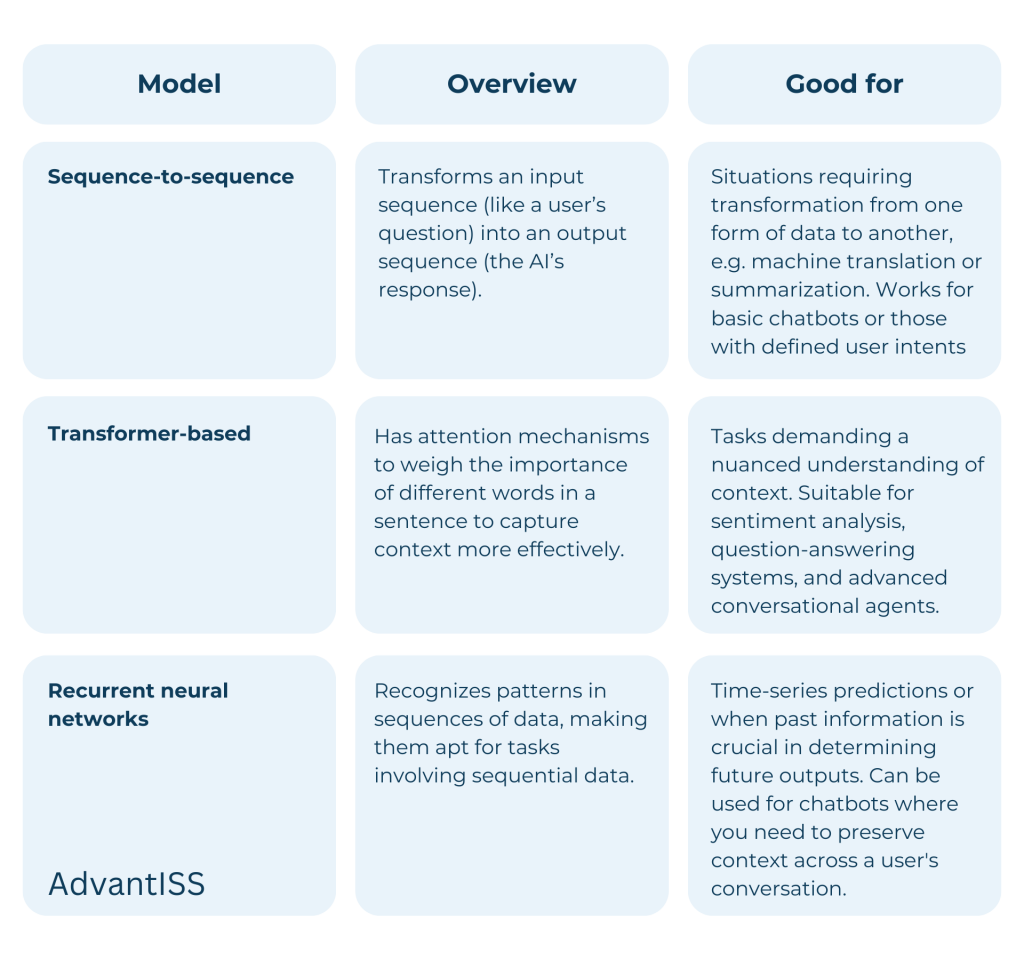Content
Conversational AI is reshaping how we engage with software. Cutting-edge apps no longer just respond to clicks, but actually interact with users in everyday language.
Gartner’s recent findings suggest something intriguing. By 2024, a quarter of our customer chats might just be with AI. So, for businesses with an eye on tomorrow, it’s high time to embrace this change.
But how can you use conversational AI in your existing or future software to create high-quality outputs? Let us run ahead of ourselves — you’ll need to cover both business and tech facets to successfully enable interactions between computers and humans through an app. Dive into this article for more details.
How can you leverage conversational AI in your software to automate business flows? Discover this in our article.
Business factors to ensure high-quality outputs with conversational AI
1. Understand the potential of chatbots and voice assistants for your organization
Conversational AI has evolved since the early days of simple text-based chatbots. That’s why leadership teams that do not keep up with recent technology updates can miss the opportunities new versions of conversational bots bring. For example, a few years ago, tech experts predicted bots would remember the context and generate responses based on that knowledge. With the release of ChatGPT and similar advanced conversational AI models, this has become a reality, and businesses now leverage these massive enhancements in conversational AI functionality for their benefit.
Also, we recommend looking at how other organizations use conversational AI. You may want to analyze the use cases of innovative companies to get a broader idea about the capabilities of each technology. Share this knowledge with the leadership team and discuss expectations around what conversational AI can and cannot do for your business.
2. Align bot capabilities with your business objectives
Just like any other strategic business decision, the implementation of speech-enabled bots and virtual assistants requires planning. What do you aim to achieve? Whether it’s to improve IT support, streamline internal processes, or provide sales assistance, a well-defined goal ensures you solve one or a few business problems with this technology.
3. Select proper use case scenarios
Based on the level of personalization you want to deliver to users, you may apply three common scenarios:
- Depersonalized answers: generic answers to common questions, e.g. Where do I find policies on sick leaves?
- Personalized answers: responses tailored to specific requests of the user, e.g. How many days of sick leave do I have left?
- Personalized transactions: You ask a bot to make a specific action on your behalf. Note that this will require identification and verifications of the user. E.g. I want to submit a sick leave to my manager through the platform.
4. Ensure a smooth user experience
Did you know that for every dollar spent on delivering a good UX companies get $100 in return (that’s a 9.900% of ROI!)? And, on the contrary, 70% of businesses fail because of poor UX. Therefore, through a well-designed UX, users can swiftly get answers, resolve issues, or access information without unnecessary hurdles while maximizing the investment.
Moreover, for many users, interacting with a chatbot or a voice assistant might be their first touchpoint with your brand. A positive and seamless experience will lead to enhanced brand perception and loyalty.
A good UX for conversational interfaces should:
- Be easy to navigate and have clear prompts — users shouldn’t have to guess what to do next.
- Have personalized greetings, be designed to recognize returning users and remember past interactions.
- Use language that is clear, concise, and free of jargon.
- Have error management for unexpected commands or questions. Instead of just stating it doesn’t understand, the system should offer the most relevant response or ask clarifying questions.
- Work across text, voice, and even visual inputs to cater to a wider range of user preferences and scenarios.
- Incorporate a feedback loop for users to rate and comment on their experience.
- Have a quick-to-respond system that is capable of handling multiple queries efficiently.
5. Confirm data privacy and compliance
Conversational AI systems often touch on sensitive data. So, keeping user data safe isn’t just good practice — it’s important for establishing trust with your customers and those involved.
So, get familiar with GDPR in Europe or CCPA in California. These are just a couple of regulations on data collection, storage, and usage you’ll want to get cozy with.
Also, limit data collection. Only gather the data you need to provide your services. Ensure all data, both in transit and at rest, is encrypted. Moreover, always obtain explicit consent from users before collecting or processing their data. Furthermore, provides options for users to withdraw consent or request data deletion.
Periodically review and assess data processing activities. This way, you will stay certain all actions align with current compliance requirements, and you handle all data securely.
Technical factors to optimize the utilization of conversational AI systems
1. Provide independent, quality data
If you plan to use the AI agent in an off-the-shelf manner for multiple applications, it’s better to divide its memory into two parts:
- Procedural memory that encodes the dialog capabilities
- Declarative memory that contains facts the agent knows
With this approach, you can replace parts or the entire declarative memory without having to change the procedural parts. For example, you may adjust the agent used as a museum guide (replace its declarative memory) to work as a city guide.
Also, the data you feed to the agent should be pertinent to the specific use -case. If you use irrelevant information, this may skew the AI’s learning and lead to inaccuracies in its outputs. At the same time, the data set should encompass varied scenarios, user types, and situations. Make sure it’s free of errors, duplicates, or inconsistencies.
2. Ensure integration with existing systems
Conversational AI platforms don’t function in isolation. Their true potential shines when they are seamlessly integrated into a business’s existing ecosystem. That’s how you ensure that all tools speak the same ‘language’ and operate smoothly. It also delivers data consistency across all platforms and enhances the capabilities of existing systems.
For seamless integration with current platforms, we recommend to:
- Establish clear data flow pathways to ensure data moves seamlessly and securely between the AI system and existing platforms.
- Design the environment with scalability in mind to keep up with the growing demand.
- Implement robust security protocols to provide data integrity and protection.
- Assure end-users are adequately trained to utilize the new functionalities.
- Continuously monitor the system to identify and rectify any issues.
3. Consider a proper model selection
Despite the versatility of conversational AI, its effectiveness, in large part, is determined by the foundational models it’s built upon and the precision of its training. An appropriately selected and trained model will understand user inputs better. Thus, it will offer precise and contextually relevant responses. It will also be able to produce outputs faster and adapt to new data or changing user behaviors.
When selecting a model for conversational AI, understand the specific requirements of the task at hand. Is context required? Is the bot meant for a narrow set of tasks or broad conversations? You may choose between the following key AI models.

To properly train the model, use only high-quality, diverse, and relevant training data. Employ the right metrics to assess model performance: accuracy, precision, or recall. Implement mechanisms for ongoing training to help the model remain relevant and improve over time. Periodically test both training and validation datasets to ensure their robustness and readiness for real-world applications.
Use cases of conversational AI
Across industries, conversational AI applications drive efficiency, enhance user experience, and pave the way for innovative solutions. Let’s explore how conversational AI is making a difference within different domains.
Fintech
As financial interactions become more digital and user-centric, the role of AI-driven conversation tools has never been more pivotal.
- Virtual financial assistants. AI-driven assistants curate and manage investment portfolios based on individual financial goals and risk appetites. They analyze market data to offer real-time investment advice. These bots also interact with users to help them set budgets, track expenditures, and even offer savings tips tailored to their spending habits.
- Fraud detection. AI-backed bots may be programmed to instantly reach out to users for transaction validation if suspicious activity is detected. They also learn users’ transaction habits to flag outliers or unusual transaction patterns. You may also want to use AI for multifactor authentication processes, where bots can engage with users through voice or text.
- Automated customer support. With the ability to handle multiple queries simultaneously, AI agents offer round-the-clock support. They address issues ranging from account management to technical glitches. Or they can recommend new banking products or services based on user interactions and financial behavior.
Legal tech
Legal tech is becoming a beacon of modernization within the vast world of law. The integration of AI into this sphere has opened up routes for streamlined processes, enhanced efficiency, and greater accessibility.
- Legal research. With the ability to analyze vast databases in mere seconds on demand, AI extracts specific statutes, precedents, or legal arguments and reduces the time lawyers spend on research. Also, AI can suggest potential outcomes for cases based on historical legal data.
- Client onboarding. Before a lawyer’s consultation, AI interacts with clients to gather basic information, case details, or documentation. Thanks to the calendar integration, attorneys can schedule, reschedule, or remind clients of upcoming meetings or hearings through a bot.
- Case management. With AI bots and voice assistants, lawyers keep clients informed about the current status of their cases, next steps, or any necessary actions.
Automotive
From enhancing in-car experiences to transforming customer services, AI-driven conversational tools are accelerating the drive toward a smarter automotive future.
- In-car virtual assistants. With this technology, drivers manage multimedia, adjust cabin conditions, or set navigation destinations using voice commands. They also view traffic updates, weather forecasts, or nearby points of interest.
- Customer support. Instead of sifting through hefty printed manuals, users pose specific queries about their vehicles and get instant answers. Car manufacturers also improve IT support by informing drivers about any recalls, software updates, or scheduled services.
Manufacturing
Heavy machinery and assembly lines are now seeing intelligent automation with AI-based bots and virtual assistants.
- Smart factory assistants. Along with real-time monitoring, AI assistants update workers on safety protocols, hazard alerts, or emergency evacuations. As they analyze machinery performance data, they forecast potential breakdowns to enable timely interventions and reduce downtimes.
- Vendor interactions. With bots and VA, you can arrange communication with suppliers, from automated order placements to delivery tracking.
- Quality control. With this technology, companies interpret feedback from end-users to identify common quality issues or areas of improvement. They also gather data on detected defects and instantly relay it to relevant teams for swift corrective actions.
Education
Once limited by physical classrooms and traditional teaching methods, the education sector is now undergoing a profound transformation, partly thanks to conversational AI.
- Administrative automation. AI tools assist with enrollment and admissions. They help address prospective students’ queries, aid with form fill-ups, and even schedule campus tours.
- Personalized learning assistant. Conversational AI understands individual learning styles and paces, so it curates personalized lesson plans and resources. It offers real-time assistance to ensure students grasp concepts thoroughly without prolonged confusion or gives updates on students’ performance.
Logistics
Logistics thrives on precision, efficiency, and real-time decision-making. As it stands at the intersection of demand and supply, any enhancement in its efficiency has ripple effects across industries. So, let’s see how conversational AI strengthens this niche.
- Route optimization. Bots and virtual assistants analyze real-time traffic data, weather conditions, and roadblocks to suggest optimal routes for delivery vehicles. They also make suggestions based on current driving patterns to improve fuel efficiency and reduce operational costs.
- Warehouse management. Bots can be trained to create regular inventory summaries. They may allow staff to quickly check stock levels, product locations, or restocking schedules through simple voice or text commands.
- Intelligent customer service. This technology empowers customers to inquire about the real-time status of their shipments, shipping rates, packaging guidelines, or customs regulations.
Take the next step
Harnessing conversational AI tools requires not just expertise, but a clear vision for innovation. Advantiss has vast expertise in delivering AI solutions to our customers across different domains.
Our approach is not one-size-fits-all. We provide AI development services to cater to the unique demands of each business. Whether you need to augment your existing IT team or want to fully entrust the AI-powered software development or revamp to our qualified team, we are here to deliver the service you need to thrive. Contact us today to discover cooperation opportunities with Advantiss.




